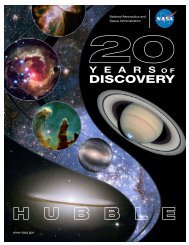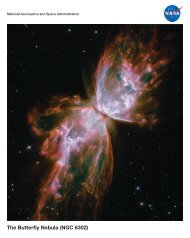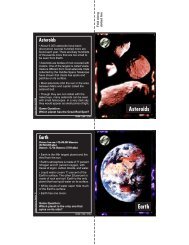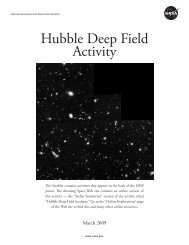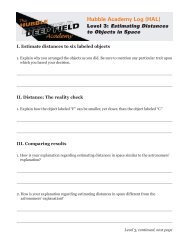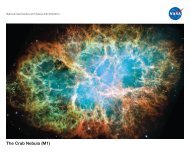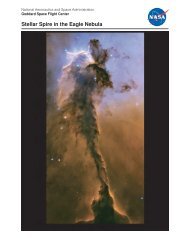Create successful ePaper yourself
Turn your PDF publications into a flip-book with our unique Google optimized e-Paper software.
<strong>The</strong> <strong>Jovian</strong> <strong>Planets</strong>
Gas Giants Inhabit the Farthest Reaches<strong>The</strong>se spectacular images of the four massive <strong>Jovian</strong>planets — Jupiter, Saturn, Uranus, and Neptune — hintat some of the remarkable attributes that set them apartfrom the smaller, rocky terrestrial planets. Also called“gas giants,” the <strong>Jovian</strong> planets occupy orbits in the outersolar system at distances ranging from 5 (Jupiter) to30 (Neptune) times the Earth’s distance from the Sun.Unlike the terrestrial planets that make up our innersolar system — Mercury, Venus, Earth, and Mars— the <strong>Jovian</strong> planets do not have solid surfaces.Instead, they are composed primarily of hydrogenand helium, with traces of methane, ammonia, water,and other gases. <strong>The</strong>se gases are tightly compressedaround relatively tiny cores of ice and rock. At greatdepths within Jupiter, for example, the hydrogen gasis compacted so tightly that it exists in a rare metallicform.Each of the <strong>Jovian</strong> planets has characteristic rings.While Saturn’s bright rings are the most visible andwell known, fainter and darker rings have been seenaround Jupiter, Uranus, and Neptune. <strong>The</strong> <strong>Jovian</strong>planets also are distinctive for having many moons— Saturn has more than 50, Jupiter has more than60, Uranus has more than 20, and Neptune has morethan 10 — as well as their deep atmospheres, strongmagnetic fields, and rapid rotation.Massive . . . Yet Lightweight<strong>The</strong> <strong>Jovian</strong> planets are enormous by any standard.Jupiter is 11 times greater than Earth in diameter andis by far the largest planet in our solar system. Saturn,at 9 times greater than Earth, is the next largest;Uranus and Neptune are both roughly 4 times greaterthan Earth.Despite their size, the <strong>Jovian</strong> planets have low densitiesbecause of their gaseous composition. Saturn,for example, is made of materials lighter than water:if placed in a giant swimming pool, the entire planetwould float.EarthUranusJupiterMercuryOrbits ofthe bodies inour solar systemSunSaturnPlutoVenusNeptuneMarsAtmospheric Conditions Lend ColorWhat we see when observing the <strong>Jovian</strong> planets isactually the tops of clouds high in their atmospheres.<strong>The</strong> colors seen in the clouds correlate with theiraltitudes: the lowest clouds are blue, followed bybrowns and whites, and then by reds at the highestlevel. Sometimes the lower layers can be seenthrough holes in the upper ones.Surprisingly, it is the trace gases in the <strong>Jovian</strong> atmospheres— not the hydrogen or helium — that givethe planets’ clouds their color. For example, Uranusand Neptune are blue-green because they have asmall amount of methane in their upper atmospheres.VOCABULARY<strong>The</strong> <strong>Jovian</strong> <strong>Planets</strong>Density: <strong>The</strong> amount of mass per volume in an objector region of space.Ice: Refers to water, methane, and ammonia, whichusually occur as solids in the outer solar system.About the images on the front of the lithograph:<strong>The</strong> images on the front of the lithographshow the four <strong>Jovian</strong> planets in their correct proportions.Jupiter (top, left) and Neptune (bottom,right) were taken with the Wide Field PlanetaryCamera 2 in visible wavelengths. Jupiter is closestto “true” color, or what it would look like to oureyes. Neptune’s colors are representative — a bitenhanced, but natural in the sense that what isblue in the image really is blue and red is red.<strong>The</strong> images of Saturn (top, right) and Uranus(bottom, left) were made with the Near InfraredCamera and Multi-Object Spectrometer in lightthat we can’t see and therefore can’t representnaturally. <strong>The</strong>se images are in “false” color — thecolors distinguish different real conditions in theplanets’ respective atmospheres.FAST FACTSEarthJupiterSaturnUranusNeptuneDiameter Distance from the Sunmiles km miles km7,92688,85074,90031,76030,77512,756142,984120,53651,11849,5289.296×10 74.836×10 88.882×10 81.784×10 92.799×10 91.496×10 87.783×10 81.429×10 92.871×10 94.504×10 9You can get images and other information about theHubble <strong>Space</strong> Telescope on the World Wide Web. Visithttp://www.stsci.edu/outreach and follow the links.National Aeronautics and <strong>Space</strong> AdministrationGoddard <strong>Space</strong> Flight Center8800 Greenbelt RoadGreenbelt, Maryland 20771<strong>STScI</strong> L-98-04 LG-1998-11-014-GSFCSPACETELESCOPESCIENCEINSTITUTEOperated for NASA by AURAeuropean space agency



